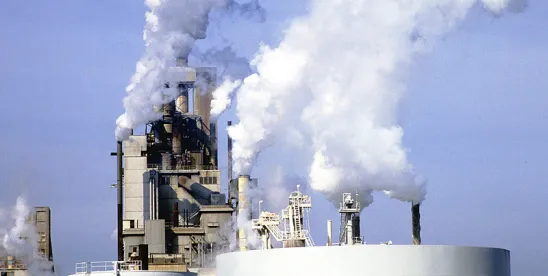The EPA seeks to reduce VOC and methane emissions by 40-45% by 2025.
On August 18, 2015, the US Environmental Protection Agency (EPA) published proposed changes to the new source performance standards (NSPS) and draft amendments to the control techniques guidelines (CTGs) for the oil and natural gas industry, seeking to further reduce volatile organic compound (VOC) and methane emissions by 40–45% from 2012 levels by 2025. NSPS are established for many industry sectors and establish minimum performance standards for new or modified sources of air pollution. CTGs are guidelines recommended by EPA to achieve NSPS. Once CTGs are finalized, states are required to evaluate the CTGs to determine if they must change their regulatory programs to accomplish EPA’s recommendations for controls as presented in the CTGs.
These proposed rules follow a series of preliminary announcements on this subject.
On January 14, 2015, EPA had announced that it planned to propose these emission reduction rules this summer. The proposed rule reflects the Obama administration’s and environmental groups’ focus on VOC emissions (as precursors to ground-level ozone formation) and on methane (as a “greenhouse gas”) from oil and natural gas operations. Many industry representatives see this proposal as duplicative, costly, and unnecessary regulation that also undercuts efforts for national energy security and economic opportunity. The oil and natural gas industry is already heavily regulated for these emissions and has achieved significant further reductions with state-of-the-art control measures implemented in the past several years.
On April 15, 2014, one month after the White House released its Strategy to Reduce Methane Emissions,[1] EPA released five white papers that lay the groundwork for new regulatory controls on VOC emissions (and, in particular, methane emissions) for oil and gas exploration, production, and midstream (transportation) operations. The papers outline estimated emissions and proposed control technologies for liquids unloading, leaks, compressors, completions, and pneumatic devices.
The proposed rules individually target the emission sources addressed by each of the white papers.[2] The proposed NSPS would add emission limits for any new, modified, and reconstructed sources based on what EPA recommends to be the best air pollution control techniques for each of the identified sources. Specifically, EPA proposes the following:
|
Sources |
Proposed Control Technologies |
|
Leaks[3] |
Semiannual optical gas imaging emission surveys (or, alternatively, an annual survey at well sites and a semiannual survey at compressor stations) and repairs within 15 days of discovering leak |
|
Compressors[4] |
Periodic replacement of rod packing systems or closed vent systems for reciprocating compressors, and closed vent systems or routing emissions to a process for wet seal centrifugal compressors |
|
Completions[5] |
Reduced emission completions, or “green completions,” in conjunction with completion combustion device |
|
Pneumatic Devices[6] |
Zero natural gas bleed rate at gas processing plants and six standard cubic feet per hour elsewhere for pneumatic controllers |
EPA is also seeking to supplement the proposed rules with other nonbinding initiatives. Last month, it released for stakeholder feedback a summary of its proposed voluntary “Natural Gas STAR Methane Challenge Program,”[7] which is intended to encourage companies to commit to achieving significant methane emission reductions through large-scale operational changes. Although EPA describes the program as offering companies flexibility to determine how they will achieve these voluntary reductions, it is unclear how such initiatives may be reconciled with the binding performance standards, as modified by the current rulemaking. In conjunction with the proposed rules, EPA also issued Control Techniques Guidelines to serve as an emission control model to reduce emissions from existing sources for states that have failed to achieve mandatory limits on ozone (which is partly attributable to VOCs). Although CTGs are technically “nonbinding,” states must consider these guidelines when evaluating their individual regulatory programs. Federal and state regulatory agencies also use the guidelines for enforcement actions.
The proposed rules and nonbinding initiatives signify EPA’s response to an active, public debate regarding VOC and methane emissions from oil and gas operations. Groups on both sides of the issue have proffered supporting evidence for their positions. Environmental groups have presented satellite imaging that they say shows atmospheric methane concentrations of approximately 1.3 million pounds per year, nearly 80% more than EPA estimates. These groups have pointed to the imaging as evidence of effects from oil and gas activities and the need for stronger regulation of methane air emissions. However, a number of researchers believe that the methane emissions that satellite imaging show are actually because of leaks associated with coal bed natural gas and not from gas extracted through hydraulic fracturing.
Overall, methane releases from oil and natural gas activities have decreased dramatically in the last several years. In fact, despite industry growth, EPA announced that the oil and gas sector has reduced greenhouse gas emissions from well sites, pipelines, and processing facilities. According to EPA, methane releases from hydraulic fracturing operations have decreased 73% since 2011, with most of that decrease attributable to technology improvements. The oil and gas sector as a whole has reduced methane emissions by 12% since 2011 and by 16% since 1991; the 2012 data that EPA relied on should be updated to reflect current conditions and information. In light of these reductions, existing controls, and EPA’s expectation of continued reductions under the existing regulations, many in the industry question the need for additional restrictions because the proposed regulations are questionable, at best. In order for the NSPS to be legally proposed and finalized, EPA is required to take into account cost, energy needs, and environmental and health considerations. Given the costs and the questionable benefits from further controls, there are serious issues as to whether EPA fulfilled its regulatory accountabilities in proposing these rules.
Finally, EPA’s NSPS do not preclude states from expanding their own VOC or methane reduction programs. On April 22, 2015, California did exactly that, releasing Draft Regulations for Greenhouse Gas Emission Standards for Crude Oil and Natural Gas Facilities.[8] The California proposal parallels the same sources covered in the EPA proposed rules (except that the California proposal also covers various types of tanks). The objective is also the same as EPA’s stated objective—the state regulators anticipate annual reductions of 556,000 million tons of greenhouse gases beginning in 2018.[9]
Interested parties will have an opportunity to provide comments, and the current framework could undergo significant changes before the rules are finalized.[10] If the changes are sufficiently substantial, EPA would have to repropose the rules.
[1]. View the action plan here.
[2]. EPA indicated that it does not have sufficient information regarding liquids unloading to include it in the proposed rule.
[3]. View the EPA report on oil and natural gas sector leaks here.
[4]. View the EPA report on natural gas sector compressors here.
[5]. View the EPA report on completions here.
[6]. View the EPA report on pneumatic devices here.
[7] View the program’s proposed framework here.
[8] View the draft regulations here.
[9] View the California Air Resources Board’s Standardized Regulatory Impact Assessment Summary here.
[10] The comment period on the EPA proposed rules will run for 60 days following publication in the Federal Register, which normally occurs within a couple of weeks of the initial release.




 />i
/>i

